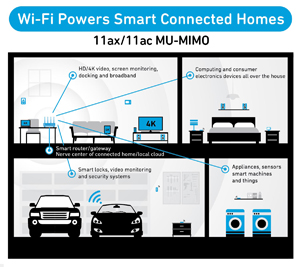Qorvo® continues to advance 802.11ax migration as customers implement its recently released portfolio of Wi-Fi front-end modules (FEMs). The company’s new 2.4 GHz and 5 GHz FEMs, and bulk acoustic wave (BAW) filters, provide the high throughput and extreme thermal efficiency that are central to high-density 802.11ax Wi-Fi connectivity.
Brad Shaffer, senior analyst, Mobile Devices & Networks at IHS Markit, said, “Qorvo’s Wi-Fi FEM and BAW filter products are examples of the RF components which will be required to enable the developing 802.11ax standard and help Wi-Fi manufacturers realize the benefits of increased capacity and broader coverage indicative of 802.11ax.”
James Klein, president, Qorvo Infrastructure and Defense Products, said, “Our customers are seeing firsthand how Qorvo technology is improving capacity and supporting multiple, high-performance Wi-Fi applications operating simultaneously in the same space. We are expanding our Wi-Fi portfolio across retail, enterprise, service provider and set-top-box markets, and will support the earliest market releases of 802.11ax solutions.”
The 802.11ax standard will deliver significantly greater capacity–which translates into more data, more devices and more services–over different frequency networks. In 2016, ABI Research forecast that 802.11ax will account for nearly 60 percent of the 21 billion Wi-Fi chipsets expected to ship by 2021.
The recently introduced Qorvo FEM family lays the foundation for 802.11ax with its support for 802.11ac and Wave 2 1024QAM. The 5GHz FEMs in the family offer more than 1.2 Gbps throughput per stream (with up to eight streams), the highest achievable data rate. These capabilities support the essential requirements of 802.11ax, such as multi-user multiple-input/multiple-output (MU-MIMO), extended range and high throughput, as well as denser-capacity Orthogonal Frequency Division Multiple Access (OFDMA) modulation. Qorvo’s BAW technology addresses thermal concerns, harmonic compliance and band-edge performance to enable broad power transmission across the full allocated spectrum. This enables maximum range and reliable throughput for Wi-Fi applications.

